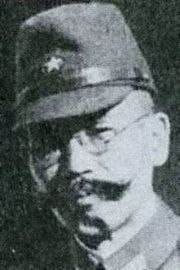- Masakazu Kawabe
-
Masakazu Kawabe 
General Masakazu KawabeBorn December 5, 1886
Toyama Prefecture, JapanDied March 2, 1965 (aged 78) Allegiance Empire of Japan Service/branch  Imperial Japanese Army
Imperial Japanese ArmyYears of service 1907–1945 Rank General Commands held North China Area Army, Central China Expeditionary Army, Inspector-General of Military Training, IJA 12th Division, Burma Area Army, Central District Army Battles/wars Second Sino-Japanese War
World War IIIn this Japanese name, the family name is "Kawabe".Masakazu Kawabe (河辺 正三 Kawabe Masakazu, 5 December 1886 – 2 March 1965) was a general in the Imperial Japanese Army. He held important commands in the Imperial Japanese Army during the Second Sino-Japanese War, and during World War II in the Burma Campaign and defense of the Japanese homeland late in the war. He was also the elder brother of General Torashirō Kawabe.
Contents
Biography
Early career
A native of Toyama prefecture, Kawabe graduated from the 19th class of the Imperial Japanese Army Academy in 1907 and the 27th class of the Army Staff College in 1915. From 1927 to 1929, he served as an instructor at the War College. He was then assigned as a military attaché to Switzerland from 1918 to 1921 and to Berlin, Germany from 1929 to 1932. Promoted to infantry colonel in 1932, he served in a number of staff assignments on his return to Japan, before being assigned command of the IJA 6th Infantry Regiment from 1932 to 1933.[1]
Kawabe went on to be Commandant of the Infantry School from 1933 to 1934, and was Chief of 1st Section within the Inspectorate General of Military Training from 1934 to 1936. He was promoted to major general in 1936 as well.
Second Sino-Japanese War
At the beginning of the Second Sino-Japanese War Kawabe was sent to China to take command of the Permanent China Brigade, had been involved in the Marco Polo Bridge Incident. As the war expanded he was made Deputy Chief of Staff of the North China Area Army from 26 August 1937 until 14 April 1938 when he became Chief of Staff Central China Expeditionary Army from 15 February 1938 to 31 January 1939.
Kawabe was promoted to lieutenant general in March 1939. During his time in China, he was involved in the Battle of Xuzhou, Northern and Eastern Honan, Battle of Wuhan, Canton Operation, Battle of Nanchang, Battle of Suixian-Zaoyang, Battle of Changsha (1939), and the 1939-40 Winter Offensive.
From 12 September 1939 to 14 October 1940 Kawabe was recalled to Japan, and held the powerful post of Inspector-General of Military Training.
However, he returned to China as commander in chief of the IJA 12th Division in March 1940, serving under the Kwantung Army. Promoted to commander in chief of the IJA 3rd Army in March 1941, he subsequently was Chief of Staff of the China Expeditionary Army from 17 August 1942 to 18 March 1943.
Pacific War
In March 1943, Kawabe was transferred to the southern front as Commander in Chief of the Burma Area Army. Arriving in Burma he was convinced to support Renya Mutaguchi, commander of the 15th Army and an old comrade-in-arms, in his plans for a pre-emptive attack against British forces at Imphal. The goal of this offensive was to disrupt the Allied build-up in that area, and perhaps, if all went well, make way for an invasion of Assam and British India. This plan was strongly opposed by most of Kawabe's commanders as well as Masazumi Inada, Vice-Chief of Staff of the Southern Expeditionary Army based in Singapore. Especially the difficult supply situation was thought to be a major obstacle. However in October 1943, Inada was removed from his position due to of a diplomatic incident with Thailand and in December the plan was approved by General Hisaichi Terauchi and Prime Minister Hideki Tōjō on the understanding the operation would be a purely defensive.[2]
Mutaguchi's plan was a tremendous disaster for the Japanese army, resulting in the highest casualties of any operation in the entire war, and the loss of Burma. During the later stages of this offensive, Kawabe was bedridden with amoebic dysentery. Kawabe was relieved by General Heitarō Kimura on 30 August 1944 and returned to Japan.[3]
Kawabe served for a short time on the Supreme War Council. In the final stages of the war, experienced commanders were needed to organize the defenses of he Japanese home islands. Kawabe became Commander in Chief of the Central Army District on 1 December 1944, he also became Commander in Chief 15th Area Army from its formation on 1 February 1945 to 7 April 1945. Kawabe was promoted to full general in March 1945. On 8 April 1945 he took command of Air General Army, consisting of the remaining air units in Japan, Korea and Okinawa, for the final defense of Japan against the anticipated Allied invasion.
After the surrender of Japan, Kawabe was retained by the SCAP occupation authoriries to assist with the demobilization of the Japanese military, replacing Kenji Doihara after the latter was arrested and tried for war crimes. Kawabe retired at the end of 1945.[4]
Preceded by
Shōjirō IidaJapanese military commander in British Crown Colony of Burma
1943–1944Succeeded by
Heitarō KimuraSee also
- Organization of Japanese Expeditionary forces in China
References
Books
- Fuller, Richard (1992). Shokan: Hirohito's Samurai. London: Arms and Armor. ISBN 1-85409-151-4.
- Hayashi, Saburo; Cox, Alvin D (1959). Kogun: The Japanese Army in the Pacific War. Quantico, Virginia: The Marine Corps Association.
External links
- Ammenthorp, Steen. "Kawabe Masakazu". The Generals of World War II. http://www.generals.dk/general/Kawabe/Masakasu/Japan.html.
- Budge, Kent. "Kawabe, Masakazu". Pacific War Online Encyclopedia. http://pwencycl.kgbudge.com/index.htm.
- World Statesmen - Myanmar (Burma)
Notes
Categories:- Japanese generals
- Japanese military personnel of World War II
- Administrators in British Burma
- People from Toyama Prefecture
- 1886 births
- 1965 deaths
Wikimedia Foundation. 2010.
